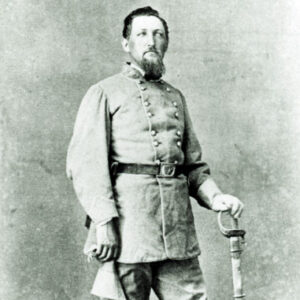calsfoundation@cals.org
Nineteenth Arkansas Infantry (CS)
The Nineteenth Arkansas Infantry Regiment was the name of several separate units that served in the Confederate army during the Civil War.
The earliest unit organized that became known as the Nineteenth Arkansas mustered in at Nashville (Howard County) in November 1861. The ten companies of the regiment were raised in Pike, Polk, Sevier, and Scott counties. The unit became known as Dawson’s Nineteenth to distinguish it from other regiments with the same number and in honor of its first colonel, C. L. Dawson.
While present at the Battle of Pea Ridge, the regiment did not see any action. One of the few units not to move east of the Mississippi River after the battle, the Nineteenth Arkansas served in western Arkansas and the Indian Territory before moving to Camp White Sulphur Springs in Jefferson County. The regiment was next assigned to Fort Hindman, where most of the members of the unit were captured in January 1863.
A portion of the unit escaped capture and continued to serve in the Trans-Mississippi Department. Combined with troops from the Twenty-fourth Arkansas and Crawford’s Infantry Battalion, who also escaped capture at Fort Hindman, the new unit became known as the Nineteenth and Twenty-fourth Consolidated Arkansas Infantry. This unit participated in the Little Rock Campaign, and in the battles at Pleasant Hill and Jenkins’ Ferry.
The portion of the unit captured at Fort Hindman spent several months in prisoner-of-war camps before being exchanged. Serving with the Confederate Army of Tennessee, the regiment consolidated with the members of the Twenty-fourth Arkansas and Crawford’s Arkansas Battalion captured at Fort Hindman and later exchanged. This unit was known as the Nineteenth/Twenty-fourth Arkansas Infantry and participated in the Battle of Chickamauga with other units captured at Fort Hindman. After the battle, the Nineteenth Arkansas was consolidated with the Eighth Arkansas while the Twenty-fourth Arkansas consolidated with other units. This led to the creation of a new regiment known as the Eighth-Nineteenth Arkansas Infantry. The unit closed out 1863 with service in the Chattanooga Campaign, seeing action at the battles at Missionary Ridge and Ringgold Gap.
The spring of 1864 saw the Eighth-Nineteenth Arkansas participating in the Atlanta Campaign. Most of the regiment was captured at the Battle of Jonesboro on September 1, 1864. After spending only eighteen days as prisoners, they were exchanged on September 19 and returned to service. Continuing to serve with the Army of Tennessee, the regiment saw action in the battles at Spring Hill, Franklin, and Nashville in the autumn and winter of 1864. The unit participated in the last campaign of the war in the Western Theater, the Carolinas Campaign. Facing off against Major General William Tecumseh Sherman, the Confederates lost at the Battle of Bentonville. The unit surrendered with the remainder of the Confederate Army of Tennessee at Bennett Place, North Carolina.
The next unit known as the Nineteenth Arkansas organized at DeValls Bluff (Prairie County) in April 1861. The regiment consisted of companies from southern Arkansas, including units from Union, Columbia, Hot Spring, Ouachita, and Lafayette counties. Hamilton Smead served as the first colonel of the regiment, but the unit would eventually become better known for a later commander, Thomas Dockery. It was called Dockery’s Nineteenth to separate it from the other units with the same designation.
The regiment joined other Confederate units moving across the Mississippi River after the Battle of Pea Ridge. Serving first at Fort Pillow, Tennessee, the regiment moved to Corinth, Mississippi, where it joined Confederate Army of Mississippi, recently defeated at the Battle of Shiloh. The entire army reorganized in May 1862, and each regiment reelected officers. Dockery was elected as the colonel of the regiment at this time.
Dockery’s Nineteenth joined the Eighteenth, Twentieth, and Twenty-first Arkansas Infantry Regiments and the Eighth and Twelfth Arkansas Infantry Battalions in a brigade commanded by Brigadier General William Cabell. Seeing action in the battles at Corinth and Davis Bridge, the regiment transferred to a brigade under the command of Brigadier General Martin Green. Serving in Mississippi during the Vicksburg Campaign, the regiment fought in the battles at Port Gibson, Champion’s Hill, and Big Black River Bridge. Green was killed at Vicksburg, and Dockery took command of the brigade. Lieutenant Colonel William Dismukes led the regiment until he was killed at Big Black River Bridge. The regiment was captured at Vicksburg but quickly paroled by Union authorities. Many of the men crossed the river back into Arkansas, and only a small number reorganized into a new unit.
Serving as mounted infantry in Arkansas, the unit participated in opposing the Camden Expedition and saw action at Moscow, Prairie D’Ane, Marks’ Mills, and Jenkins’ Ferry. The unit surrendered along with the rest of the Confederate army in the Trans-Mississippi on May 26, 1865.
For additional information:
Bearss, Edwin. Steele’s Retreat from Camden and the Battle of Jenkins’ Ferry. Little Rock: Pioneer Press, 1967.
Bradley, Mark. This Astounding Close: The Road to Bennett Place. Chapel Hill: University of North Carolina Press, 2006.
Christ, Mark K. Civil War Arkansas, 1863: The Battle for a State. Norman: University of Oklahoma Press, 2010.
Harrell, John. Confederate Military History. Vol. 10: Arkansas. Atlanta: Confederate Publishing Company, 1899.
“Soldiers and Sailors Database.” National Park Service. http://www.nps.gov/civilwar/soldiers-and-sailors-database.htm (accessed October 13, 2020).
Willis, James. Arkansas Confederates in the Western Theater. Dayton, OH: Morningside House, 1998.
David Sesser
Henderson State University
 Civil War through Reconstruction, 1861 through 1874
Civil War through Reconstruction, 1861 through 1874 Fifteenth (Johnson's) Arkansas Infantry (CS)
Fifteenth (Johnson's) Arkansas Infantry (CS) Military
Military ACWSC Logo
ACWSC Logo  Thomas Dockery
Thomas Dockery  Hardee Pattern Battle Flag
Hardee Pattern Battle Flag 




Comments
No comments on this entry yet.